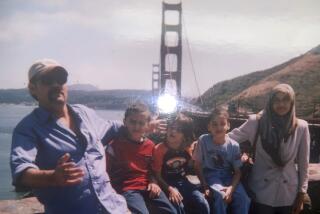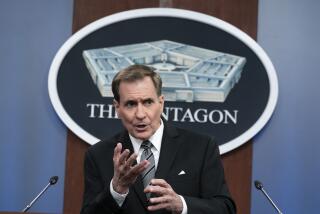U.S. Tells of Hunt for Kidnapped GIs
BAGHDAD ŌĆö The U.S. military released a timeline Tuesday that detailed its response to the abduction of two American soldiers south of the capital and the discovery of their mutilated and booby-trapped bodies more than a week ago.
But the briefing failed to explain why Pfc. Kristian Menchaca, 23, of Houston; Pfc. Thomas L. Tucker, 25, of Madras, Ore.; and a third soldier, who was killed at the site of the kidnapping, Spc. David J. Babineau, 25, of Springfield, Mass.; were outside their base camp with a single armored Humvee on the night of June 16, a Friday.
Maj. Gen. James D. Thurman declined to answer questions about possible procedural lapses that would have allowed the soldiers to leave their camp unaccompanied, saying the inquiry was continuing. U.S. military vehicles in Iraq almost always travel in groups of two or more.
U.S. and Iraqi forces staged a massive 8,000-troop, three-day search for the missing servicemen through at least a dozen villages in the Yousifiya area south of Baghdad, described by Thurman as a ŌĆ£hot bed of terrorist and foreign fighter activity.ŌĆØ
He said U.S. forces had entered the area only intermittently before October 2005 and had since established six patrol bases, counted 2,296 attacks and encountered 1,630 hidden bombs.
By the time the search for the missing troops concluded, Thurman said, U.S. and Iraqi forces had detained 36 people, 20 believed to have had links to the attack on the American soldiers. Two alleged insurgent leaders were killed during the operations, he said, and troops found 29 hidden bombs, documents and a global positioning system. Thurman said the documents and the detainees had provided useful intelligence.
On the evening of the abduction, Thurman said, U.S. soldiers stationed near Yousifiya heard gunshots and rocket blasts coming from an observation post overlooking a canal that joins the Euphrates River.
Fifteen minutes later, U.S. soldiers arrived at the site and found BabineauŌĆÖs body. Five minutes later, military officials stopped traffic in the area, and by 8:29, just more than half an hour after they heard the initial gunfire, they had launched an unmanned aerial drone and helicopters to search for the two missing soldiers.
U.S. and Iraqi special operations forces, along with dive teams, began scouring the area and searching the Euphrates for the GIs.
By early Saturday, shortly after midnight, 400 U.S. soldiers had cordoned off and searched areas north and south of the observation post. Helicopters dropped off Iraqi special operations forces at the Yousifiya power plant, an abandoned square kilometer of storage tanks, generators, towers, tunnels and other structures.
After daybreak, U.S. soldiers found a trail of evidence that led them into the power plant complex.
By Sunday morning, as search teams continued to sweep along the west bank of the Euphrates, troops started finding bombs, and a blast wounded a soldier shortly before 8.
At 6 a.m. Monday, a detainee told U.S. soldiers that the remains of the missing GIs were near a village called Mufaraji, north of the Yousifiya power plant. About four hours later the bodies were spotted.
U.S. officials said the bodies were badly mutilated, and efforts to recover the remains were delayed by six bombs planted to kill anyone who attempted to approach the corpses.
A group linked to Al Qaeda has claimed to have abducted and killed the two soldiers. Thurman declined to name groups he believed might be responsible, but pledged that the military would ŌĆ£be relentless in pursuing the perpetrators of this event.ŌĆØ
More to Read
Sign up for Essential California
The most important California stories and recommendations in your inbox every morning.
You may occasionally receive promotional content from the Los Angeles Times.









